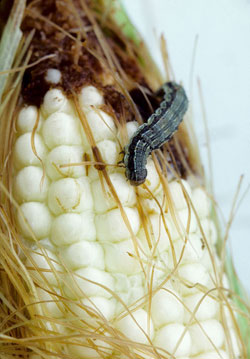Corn earworm is a serious insect problem in Colorado, especially in the southern and western parts of the state. Corn earworm larvae feed on ear tips and cause substantial injury to the ear of the corn. The corn earworm does not over-winter in Colorado. The adult moths migrate each year from southern areas and lay eggs on ear silks. Eggs hatch within a week. The larvae initially feed on silk and then move into the ear tip.
Corn earworm moths are most active during evening hours. Adult moths are about an inch long, robust and range from olive green to dark red in color. In Colorado, these moths appear in summer and are attracted to fresh corn silk where egg laying occurs. Pheromone traps are available for detecting corn earworm moths. Occurrence of moths in traps is useful for timing of control.
Ear damage from corn earworm larvae is characterized by extensive excrement at the tip of the ear. The young larvae clip off silks and then proceed into the ear where they remain until ready to pupate in the soil. There are five to six instars (larval stages) and the appearance and color of the larvae change with each instar stage.
Control of corn earworm involves biological, cultural, and chemical methods. Natural predators include small wasps, lacewings, minute pirate bugs and damsel bugs. These natural predators feed on corn earworm larvae. Early sweet corn varieties will have fewer corn earworm problems than later developing varieties.
For more information, see the following Colorado State University Extension fact sheet(s).
For more information, see the following Planttalk Colorado™ script(s).



